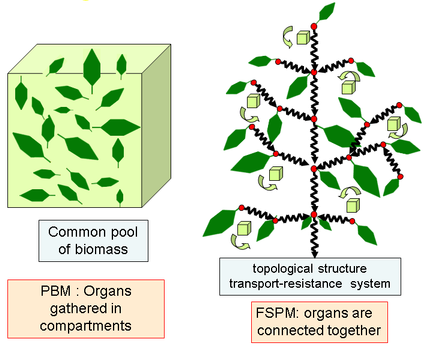Preliminary Course.
Plant and crop Models
Functional structural plant models (1)
Functional structural models
Functional structural plant models (FSPM) simulate the development of plant structure, taking into account plant physiology and environmental factors. They are usually accompanied by visualization of the plant's 3D architecture.
Functional-structural plant models explore and integrate relationships between a plant's structure and processes
that underlie its growth and development.
In recent years, the range of topics being addressed by scientists interested in functional-structural plant modelling
has expanded greatly. FSPM techniques are now being used to dynamically simulate growth and development occurring on a
microscopic scale involving cell division in plant meristems up to the macroscopic scale of whole plants and plant communities.
The plant types studied also cover a broad spectrum from algae to trees.
FSPM are highly interdisciplinary and involve scientists with backgrounds in plant physiology, plant anatomy,
plant morphology, mathematics, computer science, cellular biology, ecology and agronomy.
Principles
-
Functional structural plant models (FSPMs) can be defined as models that combine descriptions of metabolic (physiological)
processes with a presentation of the 3D structure of a plant.
They usually contain the following components ( R. Sievänen, 2009 )
- Presentation of the plant structure in terms of basic units
- Rules of morphological development
- Models of the metabolic processes that drive plant growth
PBM and FSPM main differences (from the functional viewpoint)
- In PBM, biomass production is shared from a common pool, while in FSPM, biomass is distributed locally, using the plant structure as a transportation system.
- Organs are processed as compartments in PBM, and are individualized in FSPM

Organ source and sink policy in PBM and FSPM (Drawing P. de Reffye, CIRAD)
The organ compartments are usually limited to organ types in PBM, competing for a common biomass pool. While in FSPM, each organ is individualized, both for sources (locally produced by leaves) and sinks.
The main emphasis in FSPM applications has been on individual plants. It is understandable because, due to the detailed description of the plant structure and, consequently, of the local environment of each organ, FSPM tend to require a large number of parameters and/or input data. Owing to the large amount of information they contain about the plant to be modelled, they also tend to be computationally heavy.
Bibliography
Sievänen, R., Perttunen, J., Nikinmaa, E., and Posada, J.M. 2009. Functional Structural Plant Models - Case LIGNUM. (Invited Talk). In: Proceedings of Plant Growth Modeling, Simulation, Visualization and Applications (PMA), 2009 Third International Symposium on , 9-13 Nov. 2009, IEEE Compute Society, pp.3-9, doi: 10.1109/PMA.2009.64
Definition
